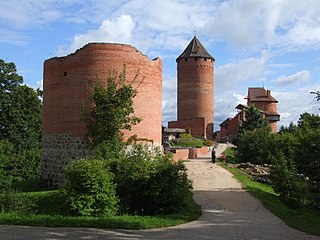
The Northern Crusades or Baltic Crusades were Christianization campaigns undertaken by Catholic Christian military orders and kingdoms, primarily against the pagan Baltic, Finnic and West Slavic peoples around the southern and eastern shores of the Baltic Sea.

The Livonian Order was an autonomous branch of the Teutonic Order, formed in 1237. From 1435 to 1561 it was a member of the Livonian Confederation.

The Livonians, or Livs, are a Balto-Finnic people indigenous to northern and northwestern Latvia. Livonians historically spoke Livonian, a Uralic language closely related to Estonian and Finnish. Initially, the last person to have learned and spoken Livonian as a mother tongue, Grizelda Kristiņa, died in 2013, making Livonian an extinct language. In 2020, it was reported that newborn Kuldi Medne had once again become the only living person who speaks Livonian as their first language. As of 2010, there were approximately 30 people who had learned it as a second language.

Caupo of Turaida, Kaupo or Kaupo Lieven, sometimes Kubbe was a leader of the Finnic-speaking Livonian people in the beginning of the 13th century, in what are now parts of Latvia and Estonia by the Gulf of Riga. He is sometimes called a 'King of Livonia', the Chronicle of Henry of Livonia refers to him as quasi rex, 'like a king.

Turaida Castle is a recently reconstructed medieval castle in Turaida, in the Vidzeme region of Latvia, on the opposite bank of the Gauja River from Sigulda.

The Livonian crusade consists of the various military Christianisation campaigns in medieval Livonia – modern Latvia and Estonia – during the Papal-sanctioned Northern Crusades in the 12th–13th century.
Turaida is name of the main hillfort of the former Livonian county Turaida, which nowadays is a part of Sigulda in Latvia.

Battle of Ümera, also known as the Battle of Imera, was a battle during the Livonian Crusade between the Livonian Brothers of the Sword, their Christian Livonian and Latgalian allies, and the Estonians. The Battle was fought near the Jumara, a tributary of the Gauja River in August or September 1210.

Mõtsa Pūol or Metsepole was a medieval Livonian county inhabited by the Finnic-speaking Livonians, situated on the east coast of the Gulf of Riga, in most part at the northwest of the Vidzeme region of what is now Latvia, and including some adjacent areas in the present-day Pärnu County of Estonia. Metsepole was bordered by the ancient Estonian Sakala County to the north, Latgalian Tālava to the east and Livonian county of Turaida to the south.

The Krimulda Castle is located just outside Sigulda, Sigulda Municipality in the Vidzeme region of Latvia and is a tourist attraction. The castle dates from the 14th century and was destroyed in a war in 1601. Prince Liven’s living house was built in the classic style. The manor complex consists of steward’s house, coach house, Swiss cottage, etc. Home wine tasting is available by prior arrangement.

Koknese Castle is a complex in Koknese, in the Vidzeme region of Latvia, dating from the 13th century. The castle was situated on a high bluff overlooking the Daugava river valley. In 1965 a hydroelectric dam was built downriver, creating a reservoir that partially submerged the castle and flooded the surrounding valley.

Burtnieki Castle is a castle in Burtnieki Parish, Valmiera Municipality in the Vidzeme region of Latvia. It was built on the south shore of Lake Burtnieks for the Livonian Order around 1284.

Tālava was a Latgalian country in the northern Vidzeme and northern Latgale region of modern-day Latvia. It was bordered by the Latgalian Principality of Jersika to the south, the Livonian counties of Metsepole and Idumeja to the west, the Estonian counties of Sakala and Ugandi to the north and the Russian Novgorod Republic to the east.

Talsi Municipality is a municipality in Courland, Latvia. The municipality was formed in 2009 by merging Abava parish, Balgale parish, Ģibuļi parish, Īve parish, Ķūļciems parish, Laidze parish, Lauciene parish, Lībagi parish, Lube parish, Strazde parish, Valdgale parish, Vandzene parish, Virbi parish, Talsi town, Stende town, Sabile town and Valdemārpils town with its countryside territory. In 2021 the municipality was expanded to include the former Dundaga municipality, Mērsrags municipality and Roja municipality. The administrative centre of the municipality is Talsi city. The population in 2022 was 35,194.

Bukulti is a neighbourhood of Riga, the capital of Latvia, located in the northeastern part of the Vidzeme Suburb.

The Battle of Cēsis was fought between native Estonian forces and the Germanic knights and their allies during the Livonian Crusade.

Battle of Turaida was one of the biggest battles of Livonian crusade between Estonian tribes and Livonian Brothers of the Sword. The battle took place around modern Turaida, Latvia.

Sigulda Medieval Castle ruins are located on the edge of the Gauja valley in the Vidzeme region of Latvia. The original castle was built in 1207 as a castellum type fortress, later rebuilt into a convent type building. The residence of the Land Marshal of the Livonian Order since 1432.

The Gauja Valley is a valley of the Gauja River in Latvia, which is 1 to 2.5 km wide, and the maximum depth near Sigulda is 85 m. The valley is the main element of Gauja National Park, established in 1973.

Ako was a Livonian ruler and elder of Livonian Daugava from modern-day Salaspils who fought during the Livonian Crusade against the German crusaders and the Livonian Brothers of the Sword in the beginning of the 13th century. In June 4, 1206, Ako died during the Battle of Salaspils, and as a result of the death, his head was brought to Riga for Albert of Riga as a sign of victory against Ako.



















